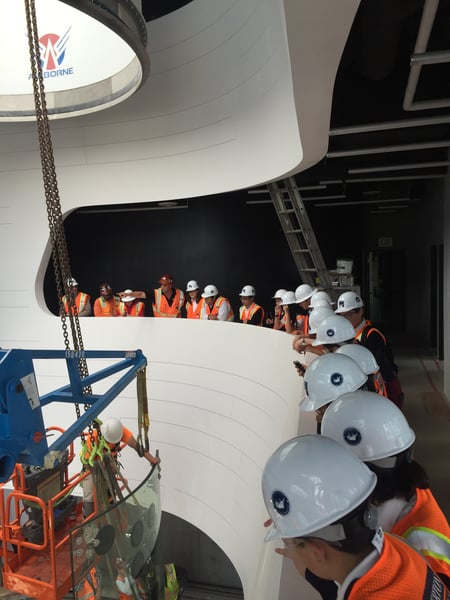Six Tips for Mentoring Architecture Students
Fri, Aug 26, 2016 Kirsten Blakeman LPA San Diego, E3 Civic High, Architecture Students, LPA Foundation, Learning Environments, Kirsten Blakeman
 As designers of 21st century learning environments, we highly value staying involved with school sites and invested in student success, even after the project has reached completion. In the case of e3 Civic High—just one year after construction finished and the school took occupancy of their LEED Gold space on the sixth and seventh floors of the San Diego Central Library—we launched an Architecture, Construction and Engineering (ACE) Mentoring program, aimed to expose the students to the fields of design.
As designers of 21st century learning environments, we highly value staying involved with school sites and invested in student success, even after the project has reached completion. In the case of e3 Civic High—just one year after construction finished and the school took occupancy of their LEED Gold space on the sixth and seventh floors of the San Diego Central Library—we launched an Architecture, Construction and Engineering (ACE) Mentoring program, aimed to expose the students to the fields of design.
As a volunteer with the ACE Mentor program, I have thoroughly enjoyed witnessing engineering and architecture students learn and grow. For mentors and mentees alike, the experience is challenging, inspiring, rewarding and most importantly, full of valuable lessons. Six lessons I am reminded of during my time as a mentor include:
It always comes back to the basics. Technology just for the sake of having the latest and greatest is not always effective. Computer-based, 3-D tools are amazing and “on trend,” but hands-on massing blocks are much more effective in STEM education and brainstorming sessions.
 Field trips are a must. If you or your student are in a creative rut, hang out in a public plaza or park, visit a building under construction, or offer your mentee a chance to shadow you while at work. Getting to know the in’s and out’s of the profession can help your student envision their future.
Field trips are a must. If you or your student are in a creative rut, hang out in a public plaza or park, visit a building under construction, or offer your mentee a chance to shadow you while at work. Getting to know the in’s and out’s of the profession can help your student envision their future.
Keep it practical. It’s easy to design something that simply looks like an inspirational photo but has little real-world value. Challenge your student to think beyond what’s already been done, or what merely looks extravagant. They’ll receive more value in designing a solution that is contextual, site-specific and unique.
Is it difficult or impossible? If your mentee is reluctant to pursue an impactful design move because constructability would be complex, challenge them to ask if the design is difficult or impossible. If it’s merely difficult, encourage them to pursue it and learn from mistakes along the way.
Design what you know. Does your mentee skateboard to and from school? Ask them to design their ideal skate park. When you’re a part of the community your project is serving, there’s an additional level of interest and investment. Encourage your mentee to bring their unique suggestions for improvement to the table; that’s called place-making.
Community is at the core. Provide spaces and services to benefit and strengthen the community. Create classrooms to teach a skill, makerspaces to implement them, galleries to display and retail spaces to sell. Create cross-collaboration opportunities and strengthen the project’s purpose. If your goal is to build community, put it at the core of your design.
With these tips, both mentors and mentees of architectural design programs will benefit from their participation. Beyond traditional educational improvements, all involved will experience increased creativity, strengthen bonds and influence local communities.
Kirsten Blakeman is a Project Manager with the Education Studio at LPA San Diego.
